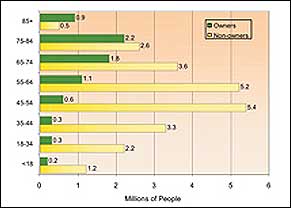CHANGE IS AN IMPORTANT FACTOR IN THE LEARNING CURVE OF SUCCESS
In a recent survey by AHAA, 80% of dispensing professionals said they spend less than 5% of their time running their practice, and 75% of respondents said they have experienced “burnout” during the past 12 months. Learn how to develop a common-sense approach to practice management with 10 simple steps.
How do you run an audiology practice, a business?
If you are the CEO of your practice, where did you get your management training? For most practice owners, the training has come “on the job,” so to speak. You completed your education, your technical training, and then either opened up your practice upon graduation or worked for a while in another practice before going it on your own.
So, you are running a practice, but are you doing the most effective job at it? Let’s see how you answer the following questions:
• Do you spend most of your time working on your practice or in it?
• Do you regularly engage in planning and business review activities?
• Do you have and are you executing a strategic plan for your practice?
• Are you frequently tired, stressed out, and overwhelmed?
Chances are your answers reveal a sense of frustration and stress. You know you should be doing more reviewing and planning, but you feel that you cannot.
You are not alone.
|
Our studies of a select group of nearly 200 American Hearing Aid Associates (AHAA) network members who are practice owners show that 80% say they spend less than 5% of their time running their practice. Moreover, fewer than 15% of them spend more than 25% of their time running the practice. Further, 75% percent of the practice owners tell us they have had feelings of “burnout” in the last 12 months.
Becoming an Effective CEO
Over the years, I have developed a group of 10 strategies that have helped me immensely in running the AHAA organization:
1. Manage change effectively
2. Plan effectively
3. Set clear expectations
4. Hold people accountable
5. Hold yourself accountable
6. Be consistent
7. Communicate effectively
8. Confront problems and resolve them quickly
9. Measure results
10. Sharpen the saw
1 Manage Change Effectively
Accept two facts as I have: 1) The ancient Greek philosopher Heraclitus said there is nothing permanent except change; 2) People do not want to change.
As you run your practice, identify what needs to change—people, activities, or both. Then, make the changes. Communicate the need for the changes, develop plans and processes for changes, and execute them.
I have found that staff meetings are one of the most useful tools for managing change. You can use them to communicate the need and rationale for change and to discuss the plan for change. The most effective use of a staff meeting is to communicate progress against the plan.
2 Plan Effectively
Develop and implement a plan for your business. One-year plans are essential for success. Five-year plans are effective in helping you see the longer range and the various internal and external factors that can affect your practice. Involve employees in setting goals and objectives, and give them clear responsibilities and decision-making guidelines. Share your final plans with them.
Analyze your Profit and Loss (P&L) statements monthly. Either the money is or is not coming in as planned. Either your expenses are or are not under control. Use this process to adjust your plan. Again, staff meetings are perfect opportunities to share with your staff the results and progress of the practice, as well as their contributions to that progress.
3 Set Clear Expectations
Do your staff members really know what is expected of them? According to a 1994 study at the University of Pennsylvania’s Wharton School, more definitive job descriptions result in:
• 25% increase in job performance.
• 50% increase in employee satisfaction.
Create a job description that is current, specific, objective, and measurable before you start interviewing for any position. The right time to begin setting job expectations is during the initial job interview. Know what you need and what you expect before you hire. Then, as you interview, discuss the job description. Don’t oversell the candidate on the job. Ensure that he or she understands what is expected.
After the hire, you must keep score. Measure and report on everything you can.
4 Hold People Accountable
Accountability means keeping everyone’s head in the game. Employees need to know how their work fits into the bigger picture. One individual not meeting goals can adversely affect the entire team. Think about accountability from the perspective of the entire group.
Salary and incentives must be aligned with performance. Documented processes and consistent reporting are essential tools. Once again, staff meetings are perfect for discussing the larger picture, as well as for reviewing group results.
5 Hold Yourself Accountable
Be resolute in executing your business plan. Hold yourself accountable to the same standards that you apply to your staff.
Understand, though, that the only thing anyone can really ever change is himself or herself, not processes. If you want employees to change, you must be willing to listen to their ideas and suggestions.
6 Be Consistent
Are you a pussycat on Monday and a tyrant on Friday? Do you allow personal feelings to enter into decision making? Be consistent. Consistency’s secret weapons include job descriptions, documented processes, staff meetings, and effective communication.
7 Communicate Effectively
Another study by the Wharton School asked executives to rate their communication skills. The study also asked their employees to rate their managers’ communication skills. The managers felt that they communicated effectively 75% of the time. The employees, however, rated their managers’ communication effective only 35%.
Fifty percent of effective communication involves listening. Communicating is a two-way street. In order to engage in it, you must listen effectively as well as voice your own thoughts. Do you listen? Place value on your employees’ diverse opinions. Facilitate their sharing information and experiences in the practice that help achieve the practice’s service and financial goals.
8 Confront Problems and Resolve Them Quickly
The greatest temptation is to ignore or avoid problems. But the problem with problems is that they do not go away. Problem employees kill productivity and morale. If the situations are not addressed, the problems usually get worse.
So, deal with problems immediately. Making no decision will usually result in significantly worse outcomes than making a bad decision.
Many problems can be prevented in the first instance with clear job descriptions and expectations. These are essential. Then, performance reviews must be conducted consistently, and performance issues must be confronted. “C” players must be gotten “up or out.”
9 Measure Results
Measure everything that can be measured, but remember that what gets measured must be managed. Analysis of your monthly P&Ls can shed light on many areas that you measure. Reporting processes can be established to measure and control others.
Some of the activities that can be measured include number of patients seen, closing rates, and number of returns. In addition, other measurable areas are inquiries converted to office visits, number of referrals, and training progress.
Finally, one of the most important components of a successful practice is patient satisfaction. This can be measured in many ways, including patient surveys, but it must be measured.
10 Sharpen the Saw
Take time out to reflect on what is going on in your practice. As you expect and enable your staff to receive additional training consistently and regularly, so should you take advantages of opportunities to obtain training, new ideas, and fresh approaches. Someone has to pump up the coach!
Burnout is one of the most prevalent feelings of a majority of the practice owners we studied. Burnout is a result of our inability to deal effectively or manage stress. It leads us to emotional exhaustion and withdrawal from our daily battles with stress. Stress is cumulative, so burnout is a process that occurs over time, sometimes as long as 3 to 6 years. When it happens, people deplete their energy and lose touch with themselves and others. This result has a terrible, negative effect on a practice.
Conclusion
Effective CEOs accept and deal with change as part of life. They create plans and set goals. They involve employees in planning and share results with them regularly—the results coming from measuring the financial progress of the practice and employee performance relative to the practice’s plans.
Effective CEOs hire carefully and well, setting clear, quantifiable expectations for new employees from the outset. They hold employees and themselves accountable for their decisions and actions, and they are consistent. They confront employee behavioral problems head on, coaching or terminating employees as necessary.
Finally, effective CEOs avoid burnout by avoiding or managing stress in the workplace and in their lifestyles. In the final analysis, there is more to life than work, and the roses are there for you to stop and enjoy them.
Correspondence can be addressed to HR or to Tina Soika, American Hearing Aid Associates (AHAA), 1380 Wilmington Pike, West Chester, PA 19382; e-mail: [email protected].




